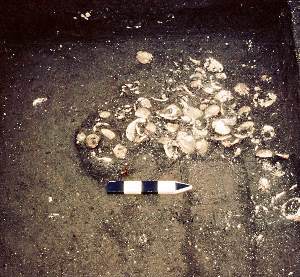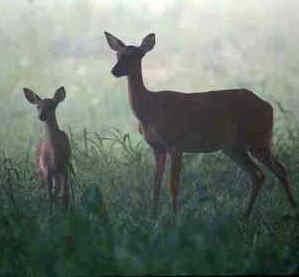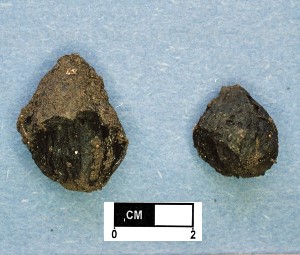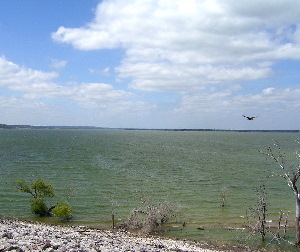Before Waco Lake: Prehistoric Life along the Bosque River
Thousands of years before the waters of the Bosque were impounded to form Waco Lake, Native American hunters and gatherers roamed throughout the fertile river valley and along its major tributaries. The material remains of their long-ago existence are scattered throughout these wooded corridors and grassy upland savannahs. Often the traces are little more than a handful of stone flakes left by a prehistoric tool maker, or a thick scatter of clam shells and deer bone—trash from a family’s meal long ago. From these often ephemeral remains, archeologists attempt to draw conclusions about what life was like in this place in the past. Prehistoric Life along the Bosque River tells the story of how hunting and gathering peoples during the Late Archaic period met the daily challenges of life through the use of several key resources found throughout their environment. This story is based on archeological investigations at three archeological sites—Britton (41ML37), McMillan (41ML162), and Higginbotham (41ML195)—at Waco Lake in McLennan County, Texas. Although evidence from earlier and later times also was uncovered, the majority of the evidence pertained to the Late Archaic. In this exhibit, we focus on that period, dating from about 2000 B.C. to A.D. 750, to best exemplify the subsistence strategies consistently used by the people of the Bosque River basin. To reconstruct the past and tell this story, a variety of models and theoretical approaches were used by researchers to help link excavated remains with human behavior. Examples of these research approaches and how they were painstakingly applied to evidence from the Waco Lake sites are included to give viewers an idea of how data are interpreted. Archeologists from Prewitt and Associates, Inc., an Austin-based cultural resource management firm, conducted these investigations. The investigations were warranted by a proposed plan to raise the conservation pool of Waco Lake (or Lake Waco, as it is also known), and were sponsored by the U.S. Army Corps of Engineers, Fort Worth District. This exhibit is a public education outreach component of that work. The three archeological sites were campsites where many diverse activities, such as tool manufacturing and food preparation, took place. No doubt because of the availability of resources, including the dependable waters of the Bosque River, hunter-gatherer families returned repeatedly to these sites. They moved their campsites often to follow and hunt animals and to harvest plants. When and where they moved was largely determined by the local abundance of these resources and by the changing seasons, which required people to have detailed knowledge about the resources in their territory. Archeologists found that while each site had its own distinctive mix of remains, all three sites contained evidence that five key resources had been used in a consistent way, representing a successful and virtually unchanged way of life for thousands of years. These key resources were white-tailed deer, plants (specifically roots, bulbs, and tubers, collectively referred to as geophytes); freshwater mussels, or clams; wood; and stone, including chert for tool-making and rocks with which to cook. Environmental SettingFormed by the merger of the North and South Bosque Rivers, Waco Lake is a reservoir behind a dam west of the city of Waco. The first dam was built in 1930 but was replaced by a new dam in the 1960s as the population of the city of Waco grew, and need for a more-dependable water supply increased. In the decades following, the conservation pool of the lake has been raised on several occasions, prompting cultural resource investigations in advance of each change. The Bosque River basin lies at the eastern edge of the Grand Prairie, a large natural region in north-central Texas that extends south from the Red River to the Llano Uplift and northern end of the Balcones Canyonlands in central Texas. This region includes the Lampasas Cut Plain and the Fort Worth Prairie. The Cut Plains exhibit the most diverse vegetation in north-central Texas and contain important habitats. Along the fertile bottomlands of the rivers and streams grow pecan, elm, oak, and pecan. The prairies hold a mixed community of grasses, including little bluestem, big bluestem, Indian grass, and side oats grama. A variety of animals, including white-tailed deer, rabbit, and coyote, thrive along the rivers and prairies today. During the early Historic Period, the mix was more diverse. Historic records document the presence of elk, bison, pronghorn antelope, black bear, wolf, mountain lion, jaguar, and ocelot. Climatic conditions varied considerably in this region in the past. During the Late Archaic period, the time the Bosque River sites predominately were occupied, the climate appears to have become wetter and possibly cooler. These changes likely affected the plant and animal communities—and the hunting and gathering peoples who depended upon them for sustenance. In This ExhibitIn the following sections, we first look at the Waco Lake sites and the work that was done during excavations and analysis. The Investigations and Findings section includes information on field methods and research approaches used and also briefly examines what was found at the three sites, including a section on the various types of cultural features that were identified. What Was It Like? is an interactive scene of the past which viewers may explore to learn more about the subsistence strategies and key resources used so successfully by Late Archaic families. Bosque River Basin and Beyond considers what has been learned and implications on a broader scale. Credits and Sources provides information about the authors and investigators and includes a list of links and references for further reading.
|
|




